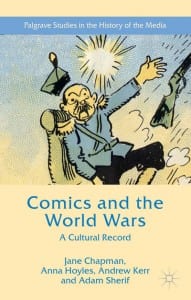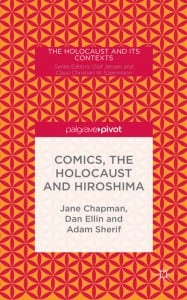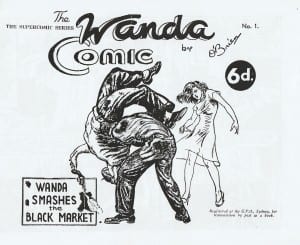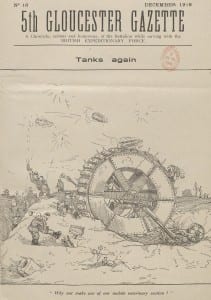Comics and the World Wars – A Cultural Record (2015)
Authors: Chapman, J, Hoyles, A, Kerr, A and Sherif, A
This monograph argues for the use of comics as a primary source by offering a highly original argument that such examples produced during the World Wars act as a cultural record.
Recuperating currently unknown or neglected strips, the authors demonstrate how these can be used for the study of both world wars, including Home Fronts, US, UK, Australian and Canadian studies, women’s history, and labour history.
Representing the fruits of over 5 years team research, the book reveals how sequential illustrated narratives:
- used humour as a coping mechanism, and a way to criticise authority.
- promoted certain forms of behaviour and discouraged others.
- represented a deliberately inclusive educational strategy for reading wartime content.
- became a barometer for contemporary popular thinking.
This important interdisciplinary, trans-national study will interest researchers in media and cultural studies, literature, history, communications, and a range of other fields in the humanities and social sciences.
ISBN: 9781137273710
To order please visit the Palgrave website
Comics, the Holocaust and Hiroshima (2015)
Authors: Chapman, J, Ellin, D and Sherif, A
Comics, the Holocaust and Hiroshima breaks new ground by arguing that comics have a dual role as sources of cataclysm between 1939 and 1945. First for historians to gauge awareness of the Holocaust and second through close analysis, of Paroles d’Etoiles in Vichy France and Barefoot Gen in Hiroshima, as testimonies of childhood emotions, experiences and memories. Calling for an extension of the range of source material relating to persecution, genocide and the atomic bomb from 1939 to 1945, comics are posited as an agent to build on the scholarship of new cultural history, historiography, memory and trauma studies. These fields connect through the shared ground of cultural record, which can be either deliberate/explicit or incidental reference. The comics form is a flexible one with potential to explore the space between reality and representation, with visuals working as iconic translations while narrative structure relies on readers’ mental contribution.
ISBN: 9781137407238
To order please visit the Palgrave website
Book Chapters
Chapman and Ellin (2015) ‘Dominion cartoon satire as trench culture narratives: Complaints, endurance and stoicism’ in: The British Empire and The First World War, ed. A. Jackson, Routledge, London. ISBN: 9781138932197
Chapman, Jane (2014) Representation of female wartime bravery in Australia’s Wanda the War Girl and Jane at War from the UK. In: Fashion and war in popular culture. Intellect Publishing, Bristol, pp. 21-34. ISBN 9781841507514
Journal articles
Chapman, Jane (2015) The Aussie, 1918-1931: cartoons, digger remembrance and First World War identity. Journalism Studies. DOI: 10.1080/1461670X.2015.1074866
Chapman, Jane and Ellin, Dan (2014) Dominion cartoon satire as trench culture narratives: complaints, endurance and stoicism. The Round Table: The Commonwealth Journal of International Affairs, 103 (2). pp. 175-192. ISSN 0035-8533
Chapman, Jane and Ellin, Daniel (2012) Multi-panel comic narratives in Australian First World War trench publications as citizen journalism. Australian Journal of Communication, 39 (3). pp. 1-22. ISSN 0811-6202
Chapman, J. (2012) Representation of female war-time bravery in Australia’s Wanda the War girl. Australasian Journal of Popular Culture, 1(2) 153-163. DOI: 10.1386/ajpc.1.2.153_1




